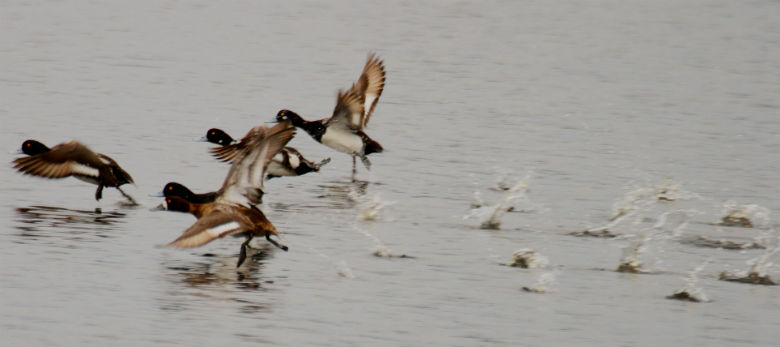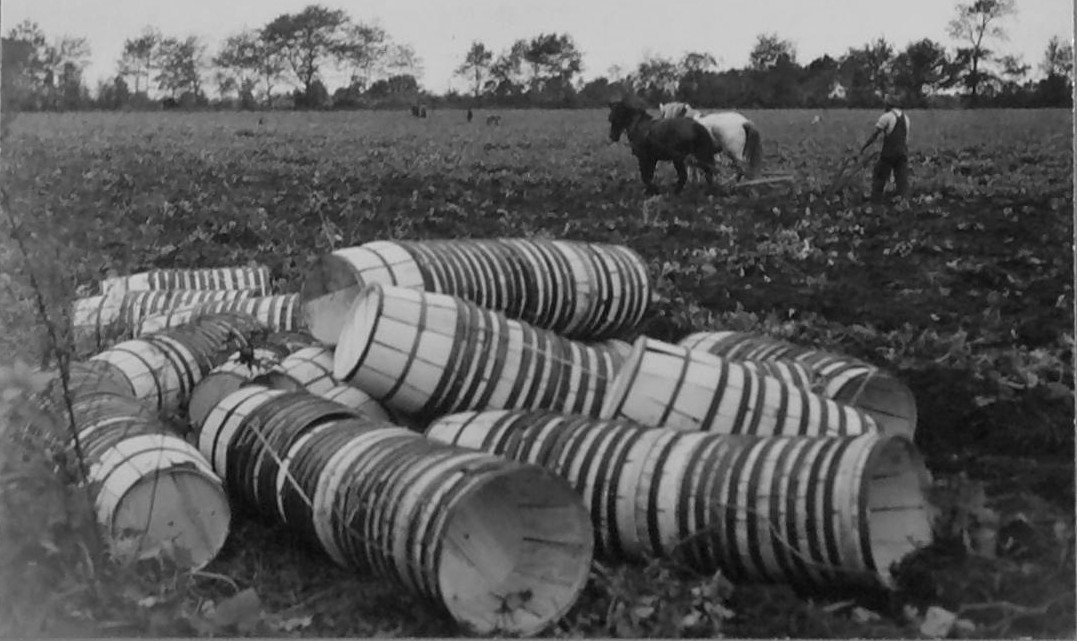Startled by the boat full of birders, a flock of lesser scaups take off from the White Oak River. Photo: Sam Bland
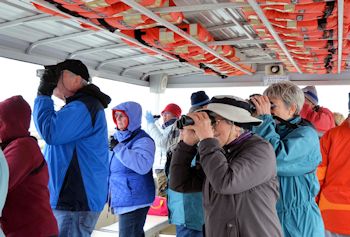 Supporter SpotlightBirders on the Lady Swan spring to action. Photo: Tess Malijenovsky |
SWANSBORO — Everyone is waiting in attention, binoculars in hand, as the Lady Swan drifts from the mainland dock at Hammocks Beach State Park. They’ve come prepared in a uniform of rain jackets, some strapped with a chest harness. One man adjusts his camera settings, knowing his subjects move swiftly. The water is as still as the air is silent on this cool, overcast morning.
“Brown pelican!” shouts a woman from the boat. Her excitement and haste is contagious. All aboard the 40-foot boat twist like owls to spot the flying target in the distance over the estuary.
As if on cue, bulky binoculars are lifted to a dozen pair of the eyes. Through the magnified lenses, birders on the boat could appreciate the way the pelican’s shoulder blades and pale yellow head draw back on its spine in flight, allowing it to cruise above water as if on autopilot. They could admire the pelican’s warrior paint, its eyes masked in black as well as its pouch, which runs along the iconic bill like the barrel of a shotgun.
It is fitting that the first bird in sight this morning on the N.C. Coastal Federation’s White Oak River birding cruise is the brown pelican, the logo of the environmental nonprofit group. “Forty years ago brown pelicans were a rare sight,” says Joanne Powell, the local birding expert who led the excursion.
Ingesting pesticides like DDT, the pelican’s calcium metabolism was so altered that its eggshells were too thin to support the weight of the incubating babies. Eggs cracked open like omelets in the nest, and pelican populations began to plummet. Brown pelicans were removed from the federal endangered species list in 1985 after DDT was banned in 1972 — a true coastal success story.
Supporter Spotlight
As drab as the sky is on this Sunday March morning, the bird action is anything but. A marsh hawk bullets through the air and into the cover of a cedar tree. Also known as a harrier, the light brown hawk is easily distinguished by the white spot on its rump, says Powell.
She is identifying birds in every direction, not only their names but any other insightful tip or knowledge. “Double-crested cormorant, 1 o’clock. The double-crested cormorant is often mistaken for the common loon,” she says and goes on to describe the difference.
Powell’s expertise comes from over 40 years of observing birds in the local ecosystem and guiding bird-watching excursions for the N. C. Maritime Museum in Beaufort. And while she clutches a bird guidebook tightly in one hand, she appears to have memorized it all.
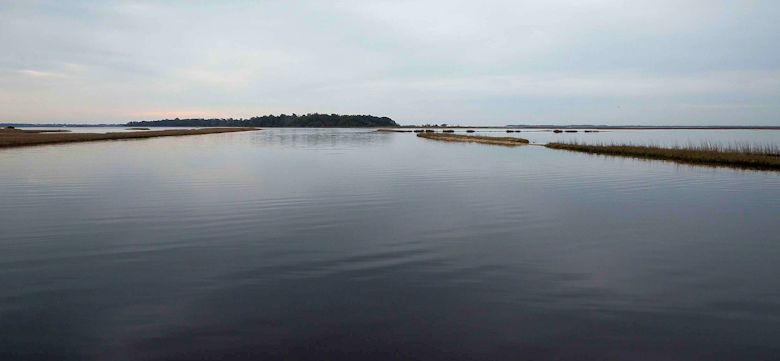
The White Oak River is as still as the air is silent on this cool, March morning. Photo: Tess Malijenovsky
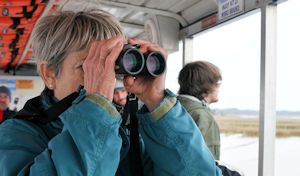
Joanne Powell, a local birding expert, volunteered to lead the cruise. Photo: Tess Malijenovsky |
On the other side of the boat there is a sandbar where gulls and terns are congregating along with lesser scaups, a blue-billed duck with a white belly. A pair of mallard ducks on the opposing beach is another indication that winter lingers. The ducks will soon leave once spring decides to stay.
Properly identifying a bird is as much fun as spotting one, or at least so it seems. “I was totally wrong and I was dubious to begin with,” says Carol Reigle of Morehead City, a longtime birder who in this instance misidentifies a bird. The birders consult each other about the color of a bird’s neck or the white on its wings. What was simply a black bird before you become a birder is now a boat-tailed grackle. A walk in the woods will never be the same once there is this shift in perspective.
Over 20 people have come from across Carteret and Onslow counties for the cruise, and their motivations vary. It’s the first time for one Emerald Isle couple who hopes to learn at least one new bird name. It’s a photography challenge for C.B. Dillworth of Greenville who’s picked up his camera club’s “spring bird” challenge, a more difficult task than expected. And for Reigle, it’s one more adventure outdoors where she never knows what wildlife she’ll see this time. The wilderness, she says, is unpredictable
“Never say never,” says Reigle. “And never stop learning.”
Her birding wisdom reflects the thoughts that inspired her hobby many years ago: “Oh, isn’t that a pretty bird? What is that beautiful thing?”
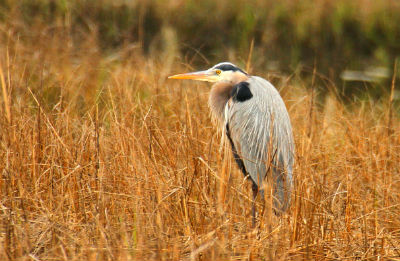
The great blue heron stands motionless as it scans for prey. Photo: Sam Bland |
Navigating expertly about the hundreds of sandbars and islands, the captains point out Bear Island and Huggins Island and Jones Island just past the Swansboro bridge, which are part of the state park.
The Lady Swan moves toward the mouth of the White Oak River, which is dark as coffee from the decayed vegetation that has leached tannins into the water. The river begins about 40 miles away up in Jones County, flowing slowly along the Croatan National Forest and eventually entering the Atlantic Ocean through Bogue Inlet. Within the two-mile span from Jones Island to the ocean, a significant change in the biodiversity can be seen.
American oystercatchers are not as common as they used to be because of habitat loss, although they are found in no shortage on today’s cruise. As their name suggests, the boldly patterned birds are seen feeding on an emerged oyster bed, plucking the bivalves with their slender, blood-orange bills. A large herring gull swoops into frame.
“That’s an immature herring gull. It’s larger than mature herring gulls, kind of like baby fat,” Powell says.
Powell has noticed some changes in bird species over the years: “There used to be hundreds of glossy ibis, which have recently become a rare sighting. More commonly spotted throughout the year is the white ibis.” She has also noticed more bald eagle nests, which used to be rare.
Although no white ibis were seen this time, no birding cruise on the White Oak River is the same. As the seasons change so do the wildlife activity. The federation has three birding cruises in the spring and three in the fall. You can register for the next birding cruise Sunday, April 13, from 10 a.m. to 12 p.m.

